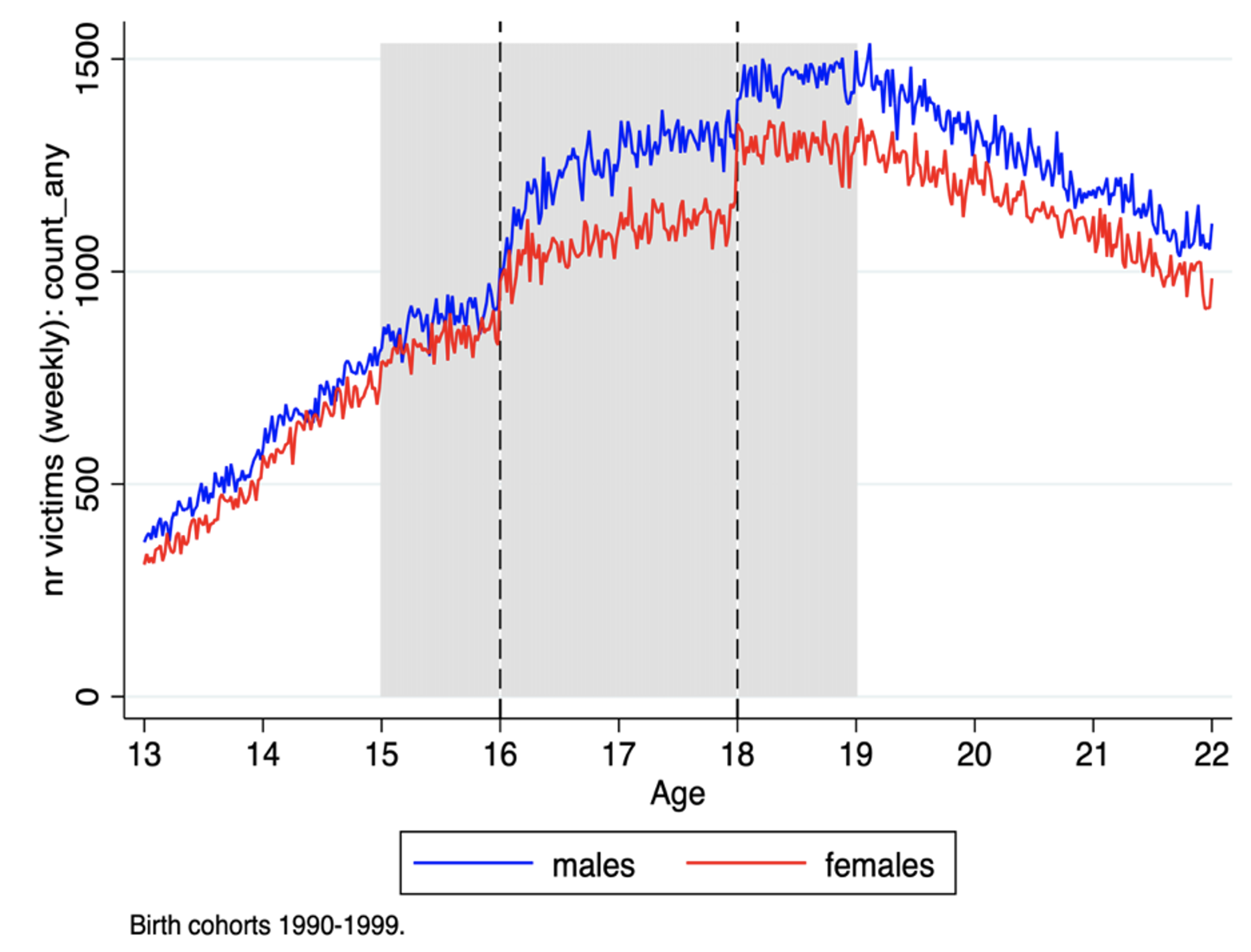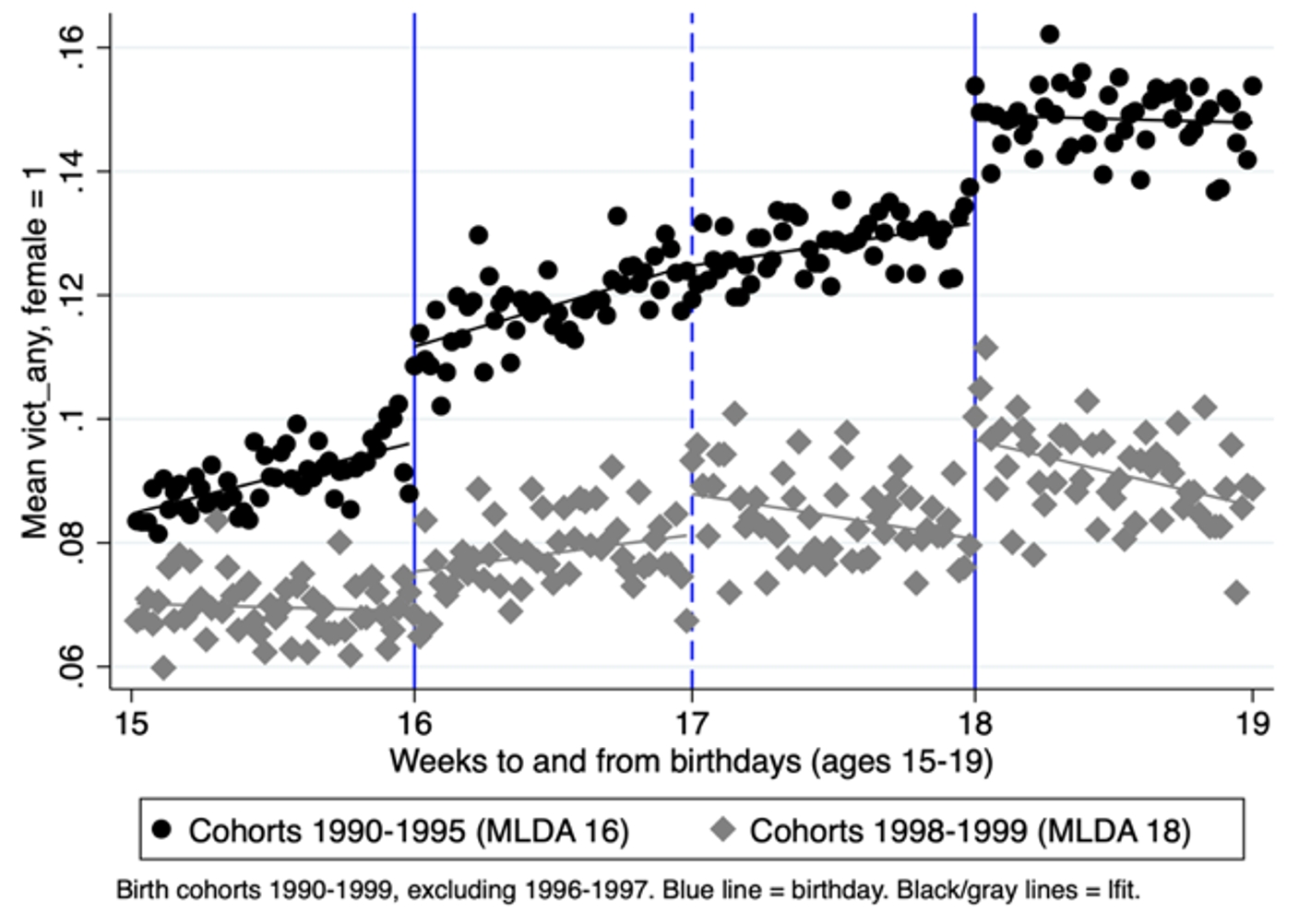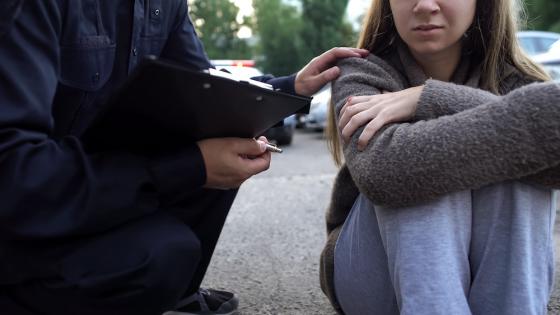Most crimes are not victimless. In the US, about 4% of respondents to the National Crime Victimisation Survey report being a victim of crime in just the last six months; similar or larger rates are seen worldwide and over time (Bindler et al. 2020). There is increasing evidence that the individual and societal costs associated with being the victim of a crime (‘victimisation’) are large: victimisation harms (mental) health and labour market outcomes for adults (e.g. Bindler and Ketel 2022 and forthcoming, Ornstein 2017, Cornaglia et al. 2014, Currie at al. 2018) and educational outcomes for juveniles (e.g. Monteiro and Rocha 2017, Foureaux-Koppensteiner and Menezes forthcoming, Chang and Padilla-Romo 2020). Despite these severe consequences, just a handful of papers study the determinants of victimisation (e.g. Vollaard and van Ours 2011a, 2011b, Card and Dahl 2011). These papers focus mostly on adults and highlight the role of precautionary behaviour, being in the same environments as potential offenders, and most recently, the role of alcohol (Chalfin et al. forthcoming).
In a recent paper (Bindler et al. 2021), we take a broader perspective and study the age-victimisation profile for juveniles to better understand the causes of victimisation, just as studies of the age-crime profile have informed our understanding of the causes of crime. Using unique register data of all reported victimisations in the Netherlands between 2005 and 2018 – linked to national population registers that include day of birth – we observe sharp and discontinuous increases in victimisation risk as individuals turn 16 and 18, and only at these birthdays (see Figure 1). We hypothesise that increased victimisation might be due to rights granted at these ages: the right to drive a moped (16), purchase alcohol and tobacco and enter bars and clubs (originally at age 16, increased to age 18 in 2014), enter marijuana-selling coffeeshops (18), and drive a car (18). These rights might change behaviour or activities – for example, where you are, when you are there, and who you are exposed to – in ways that increase the risk of victimisation (e.g. Ahammer et al. 2021, DeSimone 2010). We disentangle the role of the many rights granted at these ages using detailed offense and location data, cross-cohort variation in the minimum legal drinking age driven by the reform that increased the minimum purchasing age, and survey data of alcohol/drug consumption and mobility behaviours.
Figure 1 Age-victimisation profiles in the Netherlands (any crime)
Note: Figure 1 plots the number of victimisations (of any offense) per week (to and from birthdays) over ages 13–22 for the birth cohorts 1990–1999. Blue lines represent males; red lines females. Grey shaded areas mark the parts of the age-profile that are based on a balanced sample.
Source: Results are based on calculations by the authors using microdata from Statistics Netherlands.
Design and main findings
Identifying a causal effect between ageing and changing behaviours, such as drinking, and victimisation is challenging. First, many factors change over the life-cycle that affect the type of activities in which individuals engage as well as their risk preferences and peer group. In addition to this potential for omitted variable bias, we must also contend with potential simultaneity bias – namely, that while behaviour can affect victimisation risk, individuals may also adjust their behaviour after victimisation. We leverage exogenous shocks to young people’s rights at key birthdays as well as reforms to minimum legal drinking ages to overcome these challenges and identify how changes in behaviour and routines affect the risk of becoming a victim of crime. When we formally estimate the effect of reaching the 16th and 18th birthday thresholds using a regression discontinuity design, we find that:
- The chance of victimisation increases significantly, by about 13% for both males and females at age 16, and about 9% for males and 15% for females at age 18.
- These results are not driven by changes in reporting behaviour or by vehicle-related offences, which allows us to rule out a mechanical effect of getting a driver’s license on victimisation (e.g. one cannot have a car stolen if they do not own a car).
These estimates reflect the effect of getting access to a ‘bundle’ of rights. Also, not everyone will make use of all rights to the same extent. The detailed offence and location information in the Dutch data can provide us with more insights. In terms of the location of victimisation, we see that the risk while ‘out’ increases relative to at home. This is consistent with multiple channels that change how much an individual goes ‘out’, including moped/driving licenses and age thresholds to purchase alcohol and enter bars, clubs, or coffeeshops.
The 2014 minimum legal drinking age (MLDA) reform allows us to separate the role of alcohol-related rights from mobility-related rights. Before the reform, individuals could purchase ‘weak’ alcohol and tobacco at age 16 and ‘hard’ alcohol at 18. The reform increased the purchasing age to 18. Accordingly, bars and clubs also raised their entry age from 16 to 18. When we apply our regression discontinuity framework split by whether individuals were allowed to purchase weak alcohol at age 16 or 18, we find that victimisation risk increases at age 16 for the first group but not for the latter (see Figure 2). At the age 18 cut-off, victimisation risk increases in both groups. One hypothesis of policy makers is that it might be better to spread rights over different age cut-offs, so individuals can learn how to safely exercise these rights in a ‘softer’ environment (e.g. soft alcohol versus hard alcohol and mopeds versus cars). Taken at face value, our results do not support this hypothesis. For females, the increase at age 18 is the same for pre- and post-reform cohorts, meaning that individuals who get all alcohol-related rights only at age 18 do not ‘compensate’ for not getting access to weak alcohol at age 16. For males, the increase at 18 is slightly larger for post-reform individuals, but the overall increase in victimisation risk still seems larger for the group that could already purchase weak alcohol at age 16. Put more simply, the age-specific gap in victimisation risk between the pre- and post-reform cohorts in Figure 2 is much larger after the 18th birthday than before the 16th birthday. Of course, a caveat to the policy implications of this analysis is that we cannot say anything about whether the costs and long-term consequences of being victimised earlier (at 16) are greater than later (at 18).
Figure 2 Discontinuities in the victimisation risk by MLDA cohorts
Note: Figure 2 shows the average victimisation rates (in percentages) per week around the key birthdays (15–19) for any offense committed against females (top) and males (bottom). Black markers represent cohorts born between 1990 and 1995 that were allowed to purchase weak alcohol, tobacco, and enter bars/clubs at age 16. Grey markers represent cohorts born between 1998 and 1999 that acquired these rights at age 18. Black/grey lines represent simple linear fits.
Source: Results are based on calculations by the authors using microdata from Statistics Netherlands.
The MLDA analysis suggests that access to weak and hard alcohol, tobacco, and bars/clubs might be the most important channel driving the increases in victimisation risk. We complement these reduced-form findings with descriptive survey evidence that suggests individuals do indeed change their alcohol and going-out behaviours at the relevant age thresholds.
The detailed Dutch register data also allow us to evaluate whether these rights have different effects for sub-samples with different baseline risks of victimisation: single versus dual parent households, low versus higher income households, low versus high crime neighbourhoods, and urban versus rural municipalities (with and without coffee shops). Reaching ages 16 and 18 significantly (and comparably) increase victimisation for almost every subsample. This implies that access to these rights does not exacerbate (nor mitigate) the pre-existing inequalities in victimisation risk, and that the rights are taken up universally (not only by a specific subgroup).
Finally, given that drinking and going out are social activities that individuals typically do not engage in alone, we also assess whether there are observable peer effects associated with these rights. We do not find evidence of systematic spillovers for the peer groups observed in our analysis who are not yet eligible themselves for these rights.
Potential policy implications
Taking away these rights completely is obviously not up for debate. Rather, the relevant policy questions are perhaps related to the optimal timing of granting these rights and whether steps should be taken to offset the risks associated with them. With respect to the latter, one possibility is an increased effort to provide information and education regarding the various risks. Chalfin et al. (forthcoming) also highlight the potential for information-related policy interventions, which “have low marginal costs and, as such, are easier to scale”. With regard to timing, is there an optimal age at which to grant such rights? Should these rights be given all at the same time or spread over different age cut-offs? Our results do not support the idea that spreading the rights across ages reduce their overall impact on victimisation risk. We emphasise, however, that this is only a partial answer to the question of optimal ages for granting such rights. We shed light on the effects on victimisation – one potential cost – at ages 16 and 18. There are other benefits (e.g. the utility of alcohol consumption) and costs (e.g. drunk driving) associated with these rights. This paper cannot speak to these other costs and benefits, but rather provides insight into the differential effects of granting these rights on one important and understudied piece of the puzzle – victimisation risk. This, indeed, can be understood as one component of the price of becoming an adult.
References
Ahammer, A, S Bauernschuster, M Halla and H Lachenmaier (2021), “Minimum legal drinking age and the social gradient in binge drinking”, VoxEU.org, 27 March.
Bindler, A and N Ketel (forthcoming), “Scaring or Scarring? Labour Market Effects of Criminal Victimization”, Journal of Labor Economics.
Bindler, A and N Ketel (2022), “The far-reaching consequences of becoming a victim of a crime”, VoxEU.org, 06 February.
Bindler, A, R Hjalmarsson and N Ketel (2020), “Costs of Victimization”, Handbook of Labor, Human Resources and Population Economics, Switzerland: Springer.
Bindler, A, R Hjalmarsson, N Ketel and A Mitrut (2021), “Discontinuities in the age-victimization profile and the determinants of victimization”, IZA Discussion Paper No. 14917.
Card, D and G B Dahl (2011), “Family Violence and Football: The Effect of Unexpected Emotional Cues on Violent Behavior”, Quarterly Journal of Economics 126(1): 103–143.
Chalfin, A, B Hansen and R Ryley (forthcoming), “The Minimum Legal Drinking Age and Victimization”, Journal of Human Resources.
Chang, E and M Padilla-Romo (2020), “When crime comes to the neighborhood: Short-term shocks to student cognition and secondary consequences”, Working Paper.
Cornaglia, F, N E Feldman and A Leigh (2014), “Crime and Mental Well-Being”, Journal of Human Resources 49(1): 110–140.
Currie, J, M Mueller-Smith and M Rossin-Slater (forthcoming), “Violence While in Utero: The Impact of Assaults During Pregnancy on Birth Outcomes”, The Review of Economics and Statistics.
DeSimone, J (2010), “Binge drinking and risky sex among college students”, VoxEU.org, 30 May.
Foureaux Koppensteiner, M and L Menezes (2021), “Violence and human capital investments”, Journal of Labor Economics 39(3): 787–823
Monteiro, J and R Rocha (2017), “Drug battles and school achievement: Evidence from Rio de Janeiro’s Favelas”, The Review of Economics and Statistics 99(2): 213–228.
Ornstein, P (2017), “The Price of Violence: Consequences of Violent Crime in Sweden”, IFAU Working Paper 2017:22.
Vollaard, B and J van Ours (2011a), “Does Regulation of Built-In Security Reduce Crime? Evidence from a Natural Experiment”, Economic Journal 121(5): 485–504.
Vollaard, B and J van Ours (2011b), “Reducing the invitation to crime”, VoxEU.org, 07 July.









